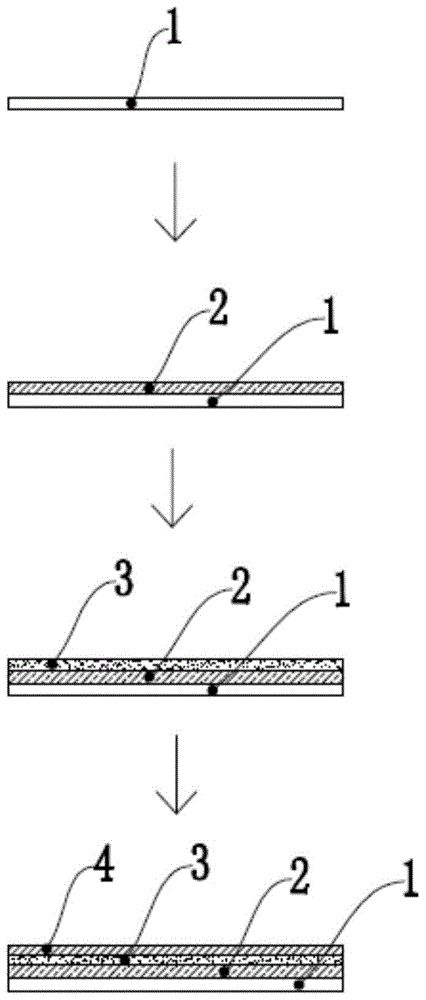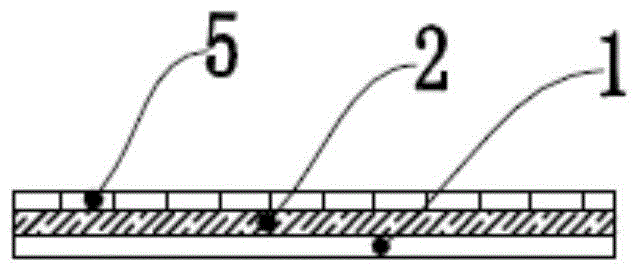A brick adobe fired into a glass-ceramic composite board at one time
A technology of glass-ceramic and glass-ceramic frit, which is applied in the field of architectural ceramics, can solve the problems of pinholes or melting holes, low yield rate, and low flatness, etc., so that there is no influence on the color effect and the yield rate is high. Effect
- Summary
- Abstract
- Description
- Claims
- Application Information
AI Technical Summary
Problems solved by technology
Method used
Image
Examples
Embodiment 1
[0025] Components of each 100kg of glass-ceramic frit particle fixative: 5.0kg of hydroxyethyl cellulose (purchased by Guangzhou Moke Building Materials Technology Co., Ltd.), 2.5kg of attapulgite, 1.1kg of polymethylsiloxane, silicone modified Sodium phosphate 1.7kg, the balance is water.
[0026] The preparation method of the above-mentioned frit granule binder comprises the following steps: a) dissolving hydroxyethyl cellulose in water, and stirring evenly; b) adding polymethylsiloxane and organic silicon-modified sodium phosphate, and stirring evenly; c) Add attapulgite and the remaining water solvent, and stir evenly to obtain a frit particle binder. The measured flow rate is 26.8s (30°C, coated with -4 cups). It should be noted that the organosilicon-modified sodium phosphate can be replaced by sodium polyacrylate or sodium hexametaphosphate as a dispersant, and this solution can also be realized.
[0027] Preparation of adobe of glass-ceramic composite board-Example 1-...
Embodiment 2
[0044] The preparation method of this example is basically the same as that of Example 1, the difference is that the components and proportions used in this example are different. The components of each 100kg frit particle binder: 5.5kg of hydroxyethyl methylcellulose (Dezhou Kangrong Chemical Co., Ltd.), 3.0kg of attapulgite, 1.4kg of polymethylsiloxane, and 2.1 kg of sodium hexametaphosphate kg, the balance being ethanol.
Embodiment 2-1
[0046] The high-temperature transparent glass-ceramic frit particles (purchased from Quincy Carloby Glaze Company, 105-145 mesh) cloth are placed on the surface of the underglaze layer of the green body through the printing process, and then one layer of the glaze obtained in Example 2 is sprayed. The glass-ceramic frit particle fixative is sent into the kiln for firing at 1170°C, and the edges are ground and chamfered to obtain a finished glazed tile with uniform distribution and complete ice crystal texture. It should be noted that the high-temperature transparent glass-ceramic frit particles selected in Example 2-1 spread stably during the sintering process, forming a silver-white ice crystal texture pattern on the glaze layer, and the glass-ceramic frit particles can pass through The color glaze company purchases and obtains, and similar frit products can also realize this scheme. The flow rate of the frit particle adhesive prepared in this embodiment is 25.7s (30°C, coate...
PUM
| Property | Measurement | Unit |
|---|---|---|
| thickness | aaaaa | aaaaa |
| particle diameter | aaaaa | aaaaa |
Abstract
Description
Claims
Application Information
 Login to View More
Login to View More - R&D
- Intellectual Property
- Life Sciences
- Materials
- Tech Scout
- Unparalleled Data Quality
- Higher Quality Content
- 60% Fewer Hallucinations
Browse by: Latest US Patents, China's latest patents, Technical Efficacy Thesaurus, Application Domain, Technology Topic, Popular Technical Reports.
© 2025 PatSnap. All rights reserved.Legal|Privacy policy|Modern Slavery Act Transparency Statement|Sitemap|About US| Contact US: help@patsnap.com


